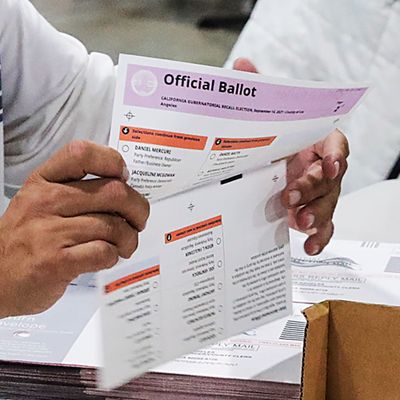
As a registered California voter, I received my mail ballot for the gubernatorial recall election about a month ago. As I reported at the time, the ballot is very weird: It features one terse question about whether to recall (with that word helpfully defined as meaning “remove”) Gavin Newsom, and another about a potential replacement for Newsom, followed by 46 names. I recognized a few — Larry Elder, Kevin Paffrath, and, of course, Caitlyn Jenner — but many of the names were totally unfamiliar.
If you pay attention to the county-election-department instructions for the ballot, you know how the two questions are related: You can vote for a replacement candidate even if you voted against the recall, but obviously the replacement contest won’t matter if the recall fails. If it succeeds, then the plurality leader of the replacement contest becomes governor immediately. It’s anybody’s guess how many voters understand these dynamics.
Team Newsom and the California Democratic Party have been worried all along that if voters gets invested in the replacement contest a dangerous number of them who aren’t necessarily Newsom-hating Republicans might vote for the recall as well. So Democrats went to considerable trouble to keep credible Democratic pols from running in the replacement race. And then, presumably for the same reason, the anti-recall campaign urged voters to leave the second question blank. Pay no attention to the replacement candidate behind the curtain seems to be the message. It’s motivated by the theory that in 2003, the last time a California governor was dragged into a recall election, Democrat Gray Davis was removed from office and Republican Arnold Schwarzenegger became governor because Democratic Lieutenant Governor Cruz Bustamante ran in the replacement contest, muddling everything.
I don’t know that I buy that theory. It’s more likely Davis was recalled because he was unpopular — a lot more unpopular than Newsom is today — while Bustamante lost to Arnold because he was less popular than Arnold. But, more basically, I resent being instructed to ignore one of two ballot questions. I fully intend to vote against the recall. I’m not a huge Newsom fan by any means, but think he should get to serve the entire term he won by a landslide less than three years ago, like every other governor in the United States. But what if I would prefer to cast a vote to help make sure that in the event the recall succeeds, we are not subsequently governed by a fascist, a charlatan, or Bobo the Simpleminded?
So I decided to hold onto my ballot until such time as I had a good sense of whether the replacement contest mattered. Now I am reasonably sure that Newsom is relatively safe, and, indeed, that the perception he was in deep trouble may have been a bit of an illusion. I have thereby decided to leave the replacement question blank, not out of obedience to Gavin Newsom, but because I really don’t want to encourage Republicans or anyone else to pull this kind of crap in the future and a low vote for the entire replacement field may help send that message.
Now my final decision is whether to take the sealed mail ballot and stroll down to my mailbox, testing my postal-delivery person’s acumen by raising the little-used “outgoing mail” red flag, or to drop it off at a designated location or the post office. Because California counts ballots postmarked by Election Day (September 14) and received within a week of Election Day (September 21), I can even loaf around for another day and still vote. This is a decision Gavin Newsom did not try to coach me on.






























